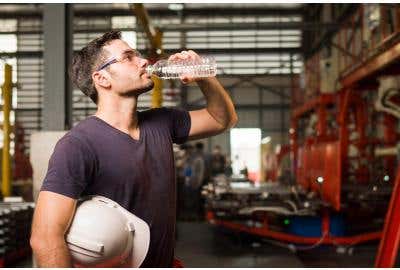Staying Safe on the Jobsite in Warm Weather


When employees work outdoors, the weather can pose many hazards against them. To prepare for the warmer months, employers should review their jobsite safety weather plans so they can protect their teams from the heat. Let's explores how to identify risk factors and maintain your team’s jobsite safety this season.
Recognizing Heat Illness Risk Factors
Heat illness is one of the worst-case scenarios for employees working in extreme temperatures. These conditions can strike anyone, even those who are in good physical health. They can even occur in temperatures as low as 70°F, making it all the more important to take precautions if any of the following risk factors are present on your worksite:
- High temperatures and humidity
- Direct sunlight
- Still air with no breeze
- Heavy personal protective equipment
- Other sources of heat (i.e. furnaces, exhausts, etc.)
Workers might be especially susceptible if they are moderately or heavily exerting themselves, not drinking enough water, or taking certain medications. Ensure that your team discloses any health factors they have that may be agitated by the heat before the summer workdays begin.
Preventing Heat Illness on Your Worksite
No matter what time of year it is, managers, employees, and all other worksite professionals must be mindful of safety strategies, including the following:
Proper Acclimation
One of the best ways to prevent heat illness from occurring is to properly acclimate team members to their hot work environments. To do so properly, follow these simple steps:
For new workers and those returning from an absence of a week or more, start by performing 20% of the usual duration of a workday. Each day afterward, increase the duration by a maximum of 20% until reaching 100%.
For experienced workers, begin the first hot workday with 50% of the normal work duration. In the days that follow, increase this duration to 60%, 80%, and 100%, respectively.
It can take up to 14 total days for workers to become acclimated to a hot jobsite. However, once they are, their bodies will sweat more efficiently and their circulation will become better stabilized, allowing them to remain productive and safe.
Proper Hydration
Heat safety plans should have workers drinking between two to four 8 oz cups of water each hour, even if they aren’t thirsty. Similarly, jobsite professionals should avoid drinking sugary liquids, which can cause dehydration and increase the risk of heat illness.
Sun Protection
Construction and industry professionals who work in direct sunlight should apply sunscreen regularly, taking care to follow the instructions on the bottle. By adding brimmed hats and loose, light-colored clothing these preventative measure, workers can stay protected from painful sunburns, skin rashes, and the possibility of certain forms of skin cancer.
Regular Breaks
Finally, workers should take breaks as often as they need to. Take it from ClickSafety – working in hot conditions without proper strategies in place won’t only hamper your jobsite productivity, but it also poses serious harm to your team.
Prepare with ClickSafety
Make sure you and your teams are up to speed on proper jobsite safety weather strategies, which you can easily do so with ClickSafety. You can find several online safety courses and resources for construction and general industry workers that cover heat illness prevention and what resources should be in your heat illness toolbox. For more information or to register for a course, contact us today.

